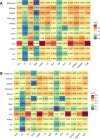StackTTCA: a stacking ensemble learning-based framework for accurate and high-throughput identification of tumor T cell antigens
- PMID: 37507654
- PMCID: PMC10386778
- DOI: 10.1186/s12859-023-05421-x
StackTTCA: a stacking ensemble learning-based framework for accurate and high-throughput identification of tumor T cell antigens
Abstract
Background: The identification of tumor T cell antigens (TTCAs) is crucial for providing insights into their functional mechanisms and utilizing their potential in anticancer vaccines development. In this context, TTCAs are highly promising. Meanwhile, experimental technologies for discovering and characterizing new TTCAs are expensive and time-consuming. Although many machine learning (ML)-based models have been proposed for identifying new TTCAs, there is still a need to develop a robust model that can achieve higher rates of accuracy and precision.
Results: In this study, we propose a new stacking ensemble learning-based framework, termed StackTTCA, for accurate and large-scale identification of TTCAs. Firstly, we constructed 156 different baseline models by using 12 different feature encoding schemes and 13 popular ML algorithms. Secondly, these baseline models were trained and employed to create a new probabilistic feature vector. Finally, the optimal probabilistic feature vector was determined based the feature selection strategy and then used for the construction of our stacked model. Comparative benchmarking experiments indicated that StackTTCA clearly outperformed several ML classifiers and the existing methods in terms of the independent test, with an accuracy of 0.932 and Matthew's correlation coefficient of 0.866.
Conclusions: In summary, the proposed stacking ensemble learning-based framework of StackTTCA could help to precisely and rapidly identify true TTCAs for follow-up experimental verification. In addition, we developed an online web server ( http://2pmlab.camt.cmu.ac.th/StackTTCA ) to maximize user convenience for high-throughput screening of novel TTCAs.
Keywords: Bioinformatics; Feature selection; Machine learning; Stacking strategy; T-cell antigen.
© 2023. The Author(s).
Conflict of interest statement
The authors declare that they have no competing interests.
Figures






Similar articles
-
PSRTTCA: A new approach for improving the prediction and characterization of tumor T cell antigens using propensity score representation learning.Comput Biol Med. 2023 Jan;152:106368. doi: 10.1016/j.compbiomed.2022.106368. Epub 2022 Nov 26. Comput Biol Med. 2023. PMID: 36481763
-
A comprehensive review and evaluation of machine learning-based approaches for identifying tumor T cell antigens.Comput Biol Chem. 2025 Oct;118:108440. doi: 10.1016/j.compbiolchem.2025.108440. Epub 2025 Apr 5. Comput Biol Chem. 2025. PMID: 40215672 Review.
-
An integrative machine learning model for the identification of tumor T-cell antigens.Biosystems. 2024 Mar;237:105177. doi: 10.1016/j.biosystems.2024.105177. Epub 2024 Mar 6. Biosystems. 2024. PMID: 38458346
-
iTTCA-MFF: identifying tumor T cell antigens based on multiple feature fusion.Immunogenetics. 2022 Oct;74(5):447-454. doi: 10.1007/s00251-022-01258-5. Epub 2022 Mar 5. Immunogenetics. 2022. PMID: 35246701
-
Large-scale comparative review and assessment of computational methods for anti-cancer peptide identification.Brief Bioinform. 2021 Jul 20;22(4):bbaa312. doi: 10.1093/bib/bbaa312. Brief Bioinform. 2021. PMID: 33316035 Free PMC article. Review.
Cited by
-
Empirical Comparison and Analysis of Artificial Intelligence-Based Methods for Identifying Phosphorylation Sites of SARS-CoV-2 Infection.Int J Mol Sci. 2024 Dec 21;25(24):13674. doi: 10.3390/ijms252413674. Int J Mol Sci. 2024. PMID: 39769436 Free PMC article. Review.
-
Tumor-Derived Antigenic Peptides as Potential Cancer Vaccines.Int J Mol Sci. 2024 Apr 30;25(9):4934. doi: 10.3390/ijms25094934. Int J Mol Sci. 2024. PMID: 38732150 Free PMC article. Review.
-
Advancing the accuracy of clathrin protein prediction through multi-source protein language models.Sci Rep. 2025 Jul 8;15(1):24403. doi: 10.1038/s41598-025-08510-4. Sci Rep. 2025. PMID: 40628826 Free PMC article.
-
BGATT-GR: accurate identification of glucocorticoid receptor antagonists based on data augmentation combined with BiGRU-attention.Sci Rep. 2025 Jul 1;15(1):21402. doi: 10.1038/s41598-025-05839-8. Sci Rep. 2025. PMID: 40595974 Free PMC article.
References
MeSH terms
Grants and funding
LinkOut - more resources
Full Text Sources
Medical

